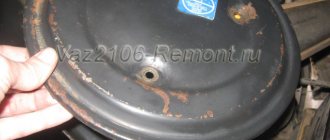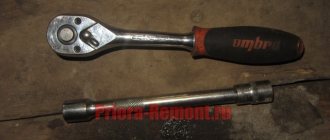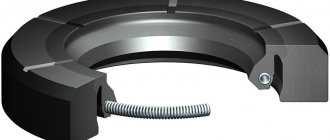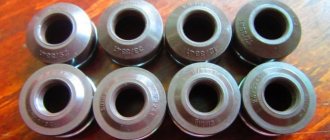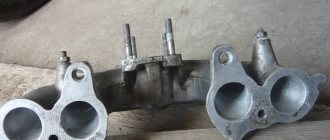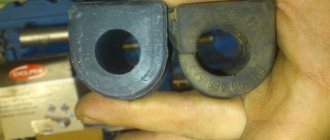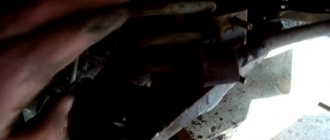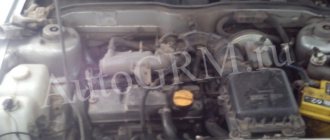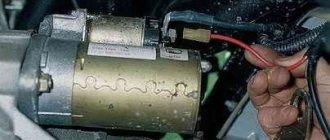A characteristic feature of domestically produced cars is that their repair and maintenance can be carried out on their own. The main thing is to have the necessary knowledge, instructions and the desire to cope with the task on your own. But still, in the case of replacing valve guides, which has a number of its own specific features, it is better to carry it out at a service station. However, many motorists cope well with this task in their own garage.
Why are guide bushings needed?
At the beginning and middle of the last century, car cylinder heads were made of cast iron, and the valves were simply inserted into precisely drilled holes. But subsequently, manufacturers abandoned cast iron heads due to their heavy weight and insufficient removal of excess heat, and they were replaced by lightweight cylinder heads made of aluminum alloys. These metals have excellent thermal conductivity, but have little resistance to wear from friction.
To solve the problem, a guide sleeve was invented - an intermediary between the soft alloy of the cylinder head and the steel valve stem, which constantly moves up and down during operation. Made of cast iron or special bronze, it is securely pressed into the cylinder head body, and the valve is inserted inside with minimal clearance.
The engine diagram shows the location of the guide bushings
The bushing itself is a hollow cylinder, made exactly to size for a specific car model. The outer surface is polished and smooth to the touch, and the inner surface has a spiral-shaped groove in the form of a thread. Motor oil moves along it, lubricating the valve axis and reducing friction. A shallow recess is made in the upper part of the guide part, into which a retaining ring is inserted.
Important point. The guide elements for the intake and exhaust groups of valves differ in design, although they may look the same in appearance (for example, parts for Russian VAZ 2108-09 cars). The difference is this: in the bushing for the exhaust tract, the oil groove is made along the entire length of the hole, and for the intake tract - only halfway. But products for the “classic” VAZ 2106 also differ in size; with the same diameter, the exhaust elements are longer than the inlet elements.
Bronze bushings for VAZ 2109 all look the same
Bushings perform the following functions:
- as the name implies, they direct the movement of the valve so that its plate is clearly aligned with the seat and fits tightly to it;
- take on the load from the friction force that occurs during the translational and reciprocal movement of the valve stem;
- the valve cup gets very hot in the combustion chamber, and the bushing transfers this heat to the aluminum alloy of the cylinder head;
- Thanks to a special groove, the part provides lubrication of rubbing surfaces.
Cast iron parts of VAZ 2106 - intake bushings are shorter than exhaust bushings
When the element is pressed into the cylinder head hole, its upper part of smaller diameter protrudes several millimeters above the surface. This is necessary to install an oil seal on it (also known as a valve seal), which prevents lubricant from the upper part of the engine from entering the combustion chamber through the inner hole of the bushing.
This is what the protruding part looks like where the oil seal is put on
Scan
Sometimes it happens that the valves do not fit into the new bushings. This is due to the fact that when pressed in, the guides change their diameter slightly. To get rid of this problem, you need to use a sweep. It allows you to bore the element to the desired diameter. It is recommended to use diamond reamers as they will last longer than steel ones. Replacing valve guides with your own hands can be done quickly if you have experience. If you don’t have it, you need to see how an experienced craftsman performs this work.
Source
Causes of parts failure and their consequences
A characteristic feature of the guide elements is that they do not fail at once, but wear out gradually. The lifespan of parts on budget cars ranges from 180 to 300 thousand km, and on more expensive foreign cars it can reach 1 million km. The wear process is influenced by several factors that can accelerate it:
- the quality of the motor oil used and the timeliness of its replacement;
- temperature conditions of the power unit, the more often the engine overheats, the faster the rubbing surfaces wear out;
- the quality of the fuel and combustible mixture, whose vapors penetrate into any leaks and contribute to the process of slow destruction of parts.
Carbon deposits on the rod destroy the bushing quite quickly
Note. The working life of all elements of the gas distribution mechanism is also affected by the serviceability of the power supply and ignition system. When, as a result of a malfunction, pops occur in the fuel or exhaust manifold, the lubricant between the valve-bushing pair is washed off with unburned gasoline, which is why the mechanism runs “dry” for several seconds.
A worn part is characterized by a “broken” internal hole, as a result of which the valve stem begins to move too freely in it, and then play appears. The rod warps during operation, and the plate does not fit well with the seat, the tightness of the interface is gradually lost. Gases escape from the combustion chamber into the mechanism, and oil enters from above, resulting in the formation of carbon deposits. It also accelerates wear, quickly rendering the part completely unusable.
When do you need to change guides?
The main symptom indicating that the valve bushings have become unusable is increased engine oil consumption. When the rod has lateral free play (play), the valve stem seals are no longer able to prevent the penetration of lubricant into the cylinders from the upper engine compartment, where the camshaft is located. It flows into the increased gap between the valve stem and the inner diameter of the bushing and freely enters the combustion chamber.
Blue smoke coming out of the exhaust is a sign of oil combustion.
Signs of oil consumption due to problems with the guides are:
- bluish smoke from the exhaust pipe from escaping combustion products of lubricant that constantly enters the cylinders;
- the car practically does not lose in dynamics, but smokes a fair amount;
- light “fluffy” carbon deposits on the spark plug electrodes;
- liquid oil is observed on the skirts and threaded parts of the spark plugs.
Advice. By the carbon deposits on the spark plugs, you can determine the cylinder into which the largest amount of lubricant gets. This will be useful for performing diagnostics.
This is oil deposits on the spark plug.
Since oil can also penetrate into the chambers due to the fault of the cylinder-piston group, it is necessary to carry out diagnostics to accurately determine the malfunction. As an example, it is proposed to take the popular VAZ 2106 car:
- Measure the compression in the cylinders. The goal is to ensure that the piston rings are in good technical condition.
- Remove the valve cover, loosen the chain and unscrew the camshaft gear, first aligning the marks.
- Dismantle the camshaft along with the bed and remove the rocker arms. Unlock the valve springs of the cylinder whose spark plug is more heavily covered with carbon deposits.
- Carefully remove the oil seal and try to rock the rod sideways with your hand, while moving it up and down.
The procedure for replacing guide valves on a VAZ 2106
The whole procedure is divided into several stages:
- Preparation of tools.
- Partial disassembly of the engine, namely, removal of the cylinder head.
- Selection and purchase of new parts.
- Dismantling worn elements and pressing in new ones.
- Reassembling and starting the engine.
The first step is to disconnect the battery from the on-board network
Advice. It is worth following exactly this sequence of actions - first disassembling the engine, and then purchasing spare parts. The dissection will show you exactly what parts you need. If you recently changed the valves (5-10 thousand km ago), then you need to pull them out to try them on with the new bushings in the store. The old valve group will have to be replaced.
Preparing the necessary tools
To disassemble and replace the guides, you will need:
- standard set of open-end and ring wrenches;
- a set of sockets with a powerful wrench and ratchet;
- a torque wrench for tightening the cylinder head bolts and camshaft nuts during assembly;
- screwdrivers, pliers;
- 36 mm wrench for manual rotation of the crankshaft;
- mount;
- puller for unlocking valves;
- heavy hammer;
- mandrel for knocking out and pressing in bushings;
- 8.025 mm reamer with knob;
- container and hose for emptying the cooling system;
- rags.
You can’t do without a ratchet wrench and sockets when removing the cylinder head.
The mandrel for working with guides is a steel rod, the end of which is machined to fit the inner diameter of the bushing. The second part of the mandrel is a nozzle for pressing, the size of which is adjusted to the wide outer part of the part (the so-called cap), since it is impossible to hit the end. The kit can be ordered from a turner or purchased ready-made; it is inexpensive.
The mandrel for knocking out and seating bushings can be machined according to the drawing
Advice. In the process of replacing the guides, you will have to re-grind the valves, or even trim the seats. This work requires a special tool and appropriate skills, so it is better to entrust the operation to a master. In addition, the purchase of devices for cutting and lapping will reduce to zero all the benefits of repairing the cylinder head with your own hands.
This is a scan used on the cylinder head of VAZ 2101-07 cars
A reamer is a bench tool designed for precise adjustment of the internal diameters of holes. In this case, it is necessary to rotate the inner part of the bushing under the valve stem with minimal clearance.
Removing the cylinder head and old bushings
This stage is the most labor-intensive and time-consuming; it begins with disconnecting the battery and emptying the water jacket of the engine (there is no need to drain the liquid from the radiator). Perform further operations in this order:
- Disconnect the starter cable, gasoline hose and accelerator drive, then remove the air filter housing and carburetor.
- Unscrew the valve cover and align the notch on the crankshaft pulley with the long notch on the block. Disconnect the wires from the spark plugs and remove the distributor, remembering the position of the slider. Remove the wire from the temperature sensor.
- Loosen the chain by unscrewing the tensioner, then unlock the camshaft gear nut and unscrew it. Remove the gear and secure the chain so that it does not fall inside the block. Unscrew the nuts securing the camshaft bed and remove it from the studs.
- Disconnect all cooling system pipes and exhaust pipe “pants” from the cylinder head.
- Loosen the 11 cylinder head bolts in random order and remove them. Using both hands, lift the cylinder head and remove it along with the manifolds.
Removing the filter housing
Advice. Immediately after dismantling the head, clean the block of the old gasket and cover it with a clean cloth so that dirt does not accidentally get inside the cylinders.
Place the removed cylinder head conveniently on the table and remove the springs with the rocker arms (it is advisable not to mix them up), then use a puller to unlock the valves and pull them out. At the same time, do not lose the “crackers” - small half-cylinders inserted into the slot of the rod. Then turn the head over with the combustion chambers facing up, place wooden blocks along the edges and knock out all the bushings with a mandrel. Strike with medium force, clearly and accurately. At the end, clean and thoroughly wipe the entire cylinder head from carbon deposits and deposits.
The carburetor must be removed from the manifold so that it does not interfere
Recommendation. Take this opportunity to inspect the disassembled engine for other faults in order to eliminate them immediately. Involve a mechanic - a motor mechanic with a device - a bore gauge, so that he can check the output in the cylinders and advise you on all issues. This is important if you are disassembling the VAZ 2106 power unit for the first time.
It is important to align the marks before disassembling
Photo instructions for removing the cylinder head
How to dismantle the cylinder head of a VAZ 2106 - video
Selection of new parts
Guide bushings for the "six" engine can be purchased in two versions - cast iron or bronze. When choosing, you should adhere to the following recommendations:
- If you have a normal driving style and are not into car tuning, there is no point in installing bronze products. Buy inexpensive cast iron guides and they will last quite a long time.
- It is better to install bronze parts together with lightweight chrome-plated valves (for example, from the AMP brand).
- Considering the price of cast iron products and your first experience of replacing them, it is recommended to purchase 2 sets of parts. The reason is the fragility of the material, which can accidentally crack if handled improperly.
- Select the bushings in such a way that the valves are inserted into them with difficulty or do not fit at all. Do not take products with incorrect holes where the rod fits freely.
- If after disassembly you find that one or more bushings are spinning or dangling in the cylinder head sockets, you need to select repair products. Their outer diameter is 0.05-0.1 mm larger than the standard one, which will allow such parts to fit into broken holes in the cylinder head. Here it is worth using measuring instruments - a micrometer and a bore gauge.
Advice. Do not listen to assurances that bronze bushings resist wear better than cast iron ones, this is not true. Cast iron is much harder than most metals, including bronze, it just transfers heat less well. Hence the conclusion: both parts are good, but they must be used for their intended purpose.
It is also worth purchasing a new valve group (if it has not been changed recently), gaskets for the cylinder head and various pipes, and 1-2 liters of antifreeze for topping up. Buy the rest of the parts based on the results of the previous troubleshooting.
Wear detection
The nature of the operation of the valve stem-bushing pair causes increased wear on the inner surface of the latter. It becomes noticeable when the vehicle is driven for a long time (about 150 thousand km). At the same time, the use of low quality oils can significantly speed up the life of the bushings. Therefore, it is always advisable to determine the degree of wear before replacing them. There are two methods for this:
- Using a micrometer paired with a bore gauge. These tools measure the minimum internal diameter of the bushing, as well as the maximum diameter of the valve stem travel area. The difference between the obtained diameters will give us the width of the required gap. When taking measurements, one should not forget about the conical and barrel-shaped nature of the wear of the rod, as well as the fact that the diameter of the bushing changes with height. All surfaces must be thoroughly cleaned of dust and dirt before starting measurements.
Set of bore gauge and micrometer for determining bushing wear - Using a dial indicator with a special stand (micrometric bore gauge or indicator-type bore gauge). If the resulting gap value goes beyond the limits indicated in the manual, then a new valve is taken and the measurement procedure is repeated. If in the second case the gap is beyond the permissible limits, it means that the spare parts need to be replaced.
Bore gauge with dial indicator for measuring clearances between the bushing and the valve
Video on replacing guide bushings
The essence of the process of replacing guides is the same for cars of any brand, the difference lies in the complexity of disassembly and the shape of the bushings. This procedure is quite labor-intensive and will take a lot of your time. Be prepared for the fact that along the way, some other malfunction will probably appear in the engine and this will also have to be eliminated. On the other hand, you will save a lot of money by replacing the bushings yourself.
Product description
Valve guide bushings BRONZE VAZ 2108 / 2110 8V (set of 8 pieces)
Increased valve guide wear can be a problem on camshafts with high valve lift. Even if the engine is equipped with a quieter camshaft, wear on the guide bushings may still be a problem. When the valve guide clearance increases, the valves may not sit evenly on the seat and leaks may develop, causing power to "leak" out of the combustion chamber. Worn bushings can also allow oil to leak into the cylinders. When oil is mixed with the working mixture, it reduces the octane number of the fuel and the fuel in the combustion chamber will already be lower in octane number; oil contamination will increase the chance of detonation, especially at high compression ratios. The best way to prevent wear on the guide bushings is to install bronze guide bushings. If this is done correctly, they will “outlast” cast iron bushings for a long time. While bronze bushings are only slightly more expensive, they are a wise investment because in addition to reducing valve-to-bushing clearances, they withstand lack of lubrication. And if you want to achieve high engine performance, then use bronze bushings.
Reviews and questions about the product:
How to remove guides
Before carrying out work, you need to warm up the entire block head to 100 degrees. The aluminum from which the head is made has a very high expansion coefficient, much less than that of the bushing. When heated, the tension of the connection between the head and the bushing decreases. In this case, you can press out the old bushings practically without damaging the seats. This is done using a sledgehammer or hammer.
Also, sometimes special mandrels are used to remove elements. With this tool you can remove the guide exactly along the axis. Many experienced craftsmen use pneumatic hammers or special drifts when replacing valve guides on a VAZ-2108.
If you can’t knock out the bushing, you’ll have to drill it out. It is best to use a machine rather than a drill. If you use a drill, the likelihood of damaging the socket increases. After dismantling, pay attention to the inner surface of the mounting sockets. They should not contain roughness, scratches, or other defects. If they are present, then you will have to additionally treat the surfaces.
